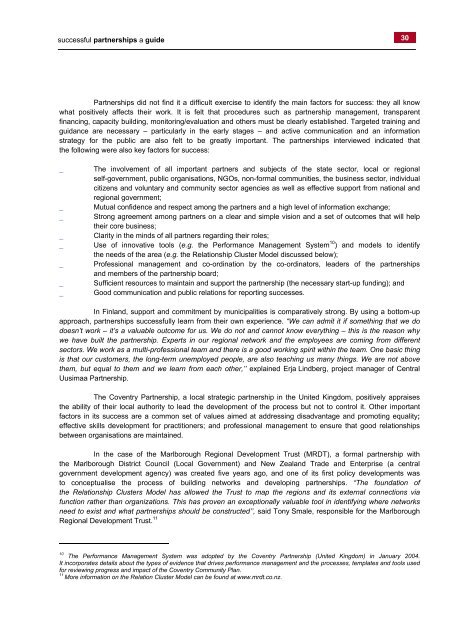successful partnerships a guide - Organisation for Economic Co ...
successful partnerships a guide - Organisation for Economic Co ...
successful partnerships a guide - Organisation for Economic Co ...
You also want an ePaper? Increase the reach of your titles
YUMPU automatically turns print PDFs into web optimized ePapers that Google loves.
<strong>successful</strong> <strong>partnerships</strong> a <strong>guide</strong><br />
30<br />
Partnerships did not find it a difficult exercise to identify the main factors <strong>for</strong> success: they all know<br />
what positively affects their work. It is felt that procedures such as partnership management, transparent<br />
financing, capacity building, monitoring/evaluation and others must be clearly established. Targeted training and<br />
guidance are necessary – particularly in the early stages – and active communication and an in<strong>for</strong>mation<br />
strategy <strong>for</strong> the public are also felt to be greatly important. The <strong>partnerships</strong> interviewed indicated that<br />
the following were also key factors <strong>for</strong> success:<br />
_<br />
_<br />
_<br />
_<br />
_<br />
_<br />
_<br />
_<br />
The involvement of all important partners and subjects of the state sector, local or regional<br />
self-government, public organisations, NGOs, non-<strong>for</strong>mal communities, the business sector, individual<br />
citizens and voluntary and community sector agencies as well as effective support from national and<br />
regional government;<br />
Mutual confidence and respect among the partners and a high level of in<strong>for</strong>mation exchange;<br />
Strong agreement among partners on a clear and simple vision and a set of outcomes that will help<br />
their core business;<br />
Clarity in the minds of all partners regarding their roles;<br />
Use of innovative tools (e.g. the Per<strong>for</strong>mance Management System 10 ) and models to identify<br />
the needs of the area (e.g. the Relationship Cluster Model discussed below);<br />
Professional management and co-ordination by the co-ordinators, leaders of the <strong>partnerships</strong><br />
and members of the partnership board;<br />
Sufficient resources to maintain and support the partnership (the necessary start-up funding); and<br />
Good communication and public relations <strong>for</strong> reporting successes.<br />
In Finland, support and commitment by municipalities is comparatively strong. By using a bottom-up<br />
approach, <strong>partnerships</strong> <strong>successful</strong>ly learn from their own experience. “We can admit it if something that we do<br />
doesn’t work – it’s a valuable outcome <strong>for</strong> us. We do not and cannot know everything – this is the reason why<br />
we have built the partnership. Experts in our regional network and the employees are coming from different<br />
sectors. We work as a multi-professional team and there is a good working spirit within the team. One basic thing<br />
is that our customers, the long-term unemployed people, are also teaching us many things. We are not above<br />
them, but equal to them and we learn from each other,’’ explained Erja Lindberg, project manager of Central<br />
Uusimaa Partnership.<br />
The <strong>Co</strong>ventry Partnership, a local strategic partnership in the United Kingdom, positively appraises<br />
the ability of their local authority to lead the development of the process but not to control it. Other important<br />
factors in its success are a common set of values aimed at addressing disadvantage and promoting equality;<br />
effective skills development <strong>for</strong> practitioners; and professional management to ensure that good relationships<br />
between organisations are maintained.<br />
In the case of the Marlborough Regional Development Trust (MRDT), a <strong>for</strong>mal partnership with<br />
the Marlborough District <strong>Co</strong>uncil (Local Government) and New Zealand Trade and Enterprise (a central<br />
government development agency) was created five years ago, and one of its first policy developments was<br />
to conceptualise the process of building networks and developing <strong>partnerships</strong>. “The foundation of<br />
the Relationship Clusters Model has allowed the Trust to map the regions and its external connections via<br />
function rather than organizations. This has proven an exceptionally valuable tool in identifying where networks<br />
need to exist and what <strong>partnerships</strong> should be constructed’’, said Tony Smale, responsible <strong>for</strong> the Marlborough<br />
Regional Development Trust. 11<br />
10<br />
The Per<strong>for</strong>mance Management System was adopted by the <strong>Co</strong>ventry Partnership (United Kingdom) in January 2004.<br />
It incorporates details about the types of evidence that drives per<strong>for</strong>mance management and the processes, templates and tools used<br />
<strong>for</strong> reviewing progress and impact of the <strong>Co</strong>ventry <strong>Co</strong>mmunity Plan.<br />
11<br />
More in<strong>for</strong>mation on the Relation Cluster Model can be found at www.mrdt.co.nz.








